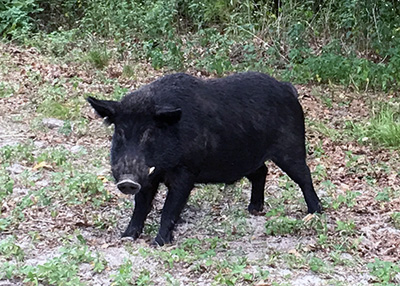Nuisance Wildlife

A feral pig. Photo: Florida Fish and Wildlife Conservation Commission, Bugwood.org
Living in Florida can often mean encountering wildlife on a regular basis. Many of these experiences are enjoyable, while others are unpleasant. Knowing why animals do what they do can help you figure out solutions when their behavior bothers you.
Snakes prefer shaded areas (like your firewood pile) where they might find a tasty toad or mouse. Armadillos don't excavate lawns as a prank—they're just looking for ants, grubs, and other soil-dwelling insects.
Some problems may be puzzling and require some research. For example, you may not know that the woodpecker's loud, resonating pecking is a method to mark territories. But if they're pecking your home, they may be foraging for wood-boring insects that have infested your siding.
Managing Nuisance Wildlife in Your Yard – A Series
In Florida, we are fortunate to have a wide variety of wildlife to watch and enjoy. Indeed, many homeowners attempt to attract particular types of wildlife to their yards to watch. However, wild animals can become a nuisance in some situations. This five-part series from Ask IFAS describes tactics you can use to cope with wildlife that have become a nuisance. Here we suggest a sequence of steps you can implement when wildlife are causing damage in your yard. These suggestions should help reduce wildlife damage in a practical, humane, and environmentally responsible manner.
- Cómo identificar las especies de animales responsables por el daño en tu jardín
- Dealing with Unwanted Wildlife in an Urban Environment
- How to Identify the Wildlife Species Responsible for Damage in Your Yard
- How to Modify Habitat to Discourage Nuisance Wildlife in Your Yard
- How to Use Deterrents to Stop Damage Caused by Nuisance Wildlife in Your Yard
- How to Use Traps to Catch Nuisance Wildlife in Your Yard
- Overview of How to Stop Damage Caused by Nuisance Wildlife in Your Yard

